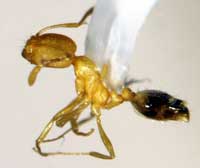Characteristics:
- Also called “sugar ant”
- Body length 1/12 to 1/16 inch long (monomorphic)
- Body coloration varies from golden yellow to reddish-brown
- Have 12-segmented antennae that ends with a 3-segmented club
- Feeds on sweets (jelly, sugar, honey, etc.), cakes and breads, and greasy or fatty foods
Pharaoh ants form large colonies consisting of many nests, which colony members that move freely between, without any antagonism. Colonies vary greatly in size. Some colonies may have only a single queen with a few hundred workers, whereas other colonies may have hundreds of queens with several thousand workers. Queens may live for a year and lay up to 35 eggs per day. Workers develop from egg to adult in 36 days. Winged males and females require about 44 days to develop. The life span of workers is about 70 days. Pharaoh ant workers are monomorphic, about 1/12 to 1/16 in. long, have twelve segmented antennae with a well-defined, three-segmented club. The abdominal pedicel is composed of two segments, the petiole and post petiole. A stinger is present but not always visible. They do not sting humans.
Distribution
The origin of the pharaoh ant, Monomorium pharaonis (Linnaeus) is uncertain, but various authorities have suggested that it originated in the Afro-tropical region. It is now cosmopolitan in distribution having been spread throughout the world by human commerce. They are found throughout the United States, and are generally found only in heated structures because they usually cannot survive outdoors all year. However, they can be found nesting in the soil outside buildings in subtropical areas such as Hawaii, Florida and southern Texas.
Management
Pharaoh ant infestations rapidly occur if the colonies are not completely eliminated. Liquid or dust formulations of repellent insecticides are not recommended indoors because they typically cause colony budding, which exacerbates the problem. Currently, the most successful control procedure to control this species is to strategically place bait stations extensively throughout structures along trails where these ants are active. It is important that workers from all colonies in the building feed on the baits. Workers will feed the bait to other members of the colony, including queens and brood. Routine inspections are necessary to determine if ants are feeding on the baits and when it is time to replace the depleted stations with fresh bait. Exterior treatments may be necessary during warm months; baits should be placed outside where the ants are observed. Depending on the magnitude of the problem, a baiting program may take several months to a year to complete.